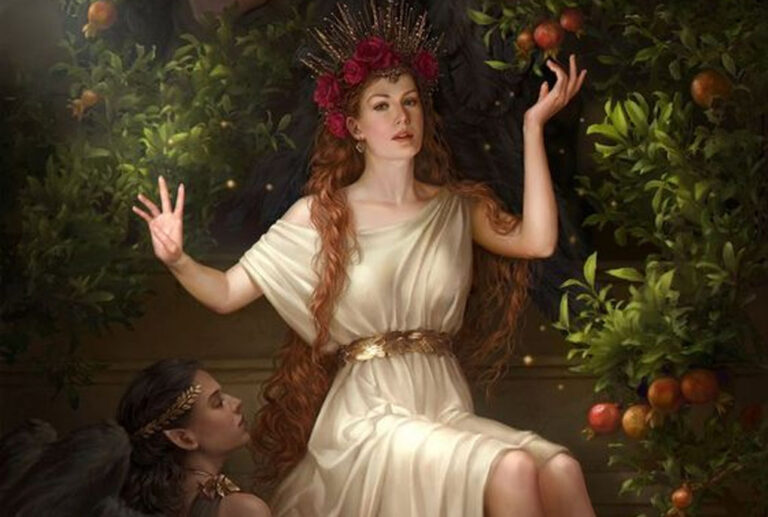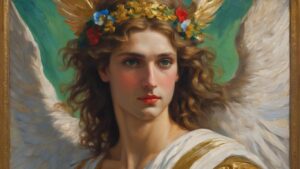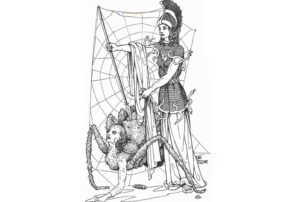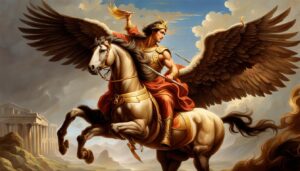Various legends and stories surround Demeter in Greek mythology. One well-known tale revolves around the abduction of her daughter Persephone by Hades, the god of the underworld. Distraught by the loss, Demeter wandered the earth, causing the crops to wither and die.
In another significant story, Demeter’s time in Eleusis involved her disguising herself as an old woman and working as a nurse for the king’s son. To express gratitude, she intended to make the child immortal by placing him in the fire each night. However, the queen discovered this and interrupted the process, leading Demeter to reveal her true identity.
The establishment of the Eleusinian Mysteries, secret religious rites dedicated to Demeter and Persephone, was in response to these myths. Furthermore, initiates believed that participation in these mysteries would ensure a more favorable afterlife.
Moreover, these legends and stories contribute to the rich tapestry of Greek mythology, highlighting Demeter’s role as a powerful and emotional deity closely tied to the cycles of nature and the mysteries of life and death.
In Greek mythology, Demeter is a member of the Olympian gods and has a notable family lineage. Additionally, she is the daughter of Cronus and Rhea, making her one of the six children of the Titan couple. Notably, her siblings include Hestia, Hera , Zeus , Poseidon , and Hades . These family connections link Demeter to the powerful generation of deities that ruled Mount Olympus.
Additionally, Demeter is the mother of Persephone, whose abduction by Hades in the myth of the Underworld plays a central role in the explanation of the changing seasons. The family dynamics and relationships among the gods and goddesses in Greek mythology often contribute to the intricate narratives and legends associated with each deity.
Demeter Demeter, a mature and regal goddess in Greek art and mythology, often appears wearing a crown or wreath made of wheat, barley, or other grains, symbolizing her association with the harvest. Moreover, typical depictions feature her holding a sheaf of wheat or a cornucopia, emphasizing her pivotal role in agriculture and abundance. Additionally, in some representations, Demeter carries a torch or a lamp, symbolizing her search for her daughter Persephone after Hades abducted her. Notably, artists portray her in a chiton (a tunic) and a himation (a draped outer garment), reflecting the clothing styles of ancient Greece. These depictions collectively highlight Demeter’s attributes and significance as the goddess of the harvest and fertility.
Various icons vividly portray the divine attributes of Demeter, the Greek goddess of agriculture and fertility. Chief among these symbols is the wheat and grain, elements that often adorn her crown or wreath, highlighting her direct association with the prosperity of the harvest. Additionally, holding a cornucopia, Demeter conveys the idea of abundance, emphasizing her pivotal role in ensuring fertility and bountiful crops.
In artistic representations, Demeter occasionally carries a torch or lamp, symbolizing her relentless search for her abducted daughter Persephone. This quest led her to wander the earth in sorrow, a narrative reflected in the imagery of the torch.
Moreover, the poppy flower holds significance in Demeter’s symbology, believed by some to have sprung from her tears shed during the mourning period for Persephone. This delicate flower adds another layer of meaning to Demeter’s connection with the cycles of life, death, and rebirth.
In certain depictions and contexts, serpents accompany Demeter, especially in relation to the Eleusinian Mysteries. These serpents symbolize mystery and transformation, contributing to the intricate symbolism surrounding the goddess.
Demeter is the goddess of agriculture, harvest, and fertility in Greek mythology.
Demeter is one of the Olympian goddesses in Greek mythology, the sister of Zeus and one of the twelve major deities residing on Mount Olympus.
Demeter is often symbolized by the sheaf of wheat or a bundle of harvested grain.
Demeter is pronounced "dih-MEE-ter."
In Roman mythology, Demeter is known as Ceres.
Demeter is typically depicted as a mature woman with a serene demeanor, often wearing a crown or wreath made of ears of wheat.
Demeter is primarily known for her role as the goddess of agriculture and the harvest. She is associated with the fertility of the earth and the growth of crops.
Demeter is the daughter of Cronus and Rhea, making her one of the children of the Titans in Greek mythology.
Demeter is often associated with fields, farms, and areas where agriculture and cultivation take place.
Demeter is married to her brother Zeus, the king of the gods. Together, they are the parents of Persephone.
Demeter resides on Mount Olympus, the mythical home of the Olympian gods in Greek mythology.
In classical Greek mythology, there is no account of Demeter's death. She is typically considered an immortal deity, and her stories revolve around her role in the divine order, particularly in connection with agriculture and the seasons.




